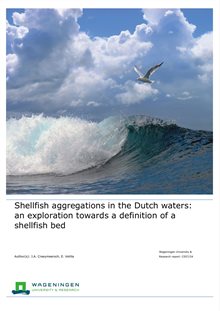J.A. Craeymeersch, E. Velilla. Shellfish aggregations in the Dutch waters: an exploration towards a definition of a shellfish bed
For the extraction of sand the permit conditions (Omgevingswet, ontgrondingenvergunning) a distance of 100 meter to living banks of shellfish is to be mainiatined during extraction. However, there is no general accepted definition of a shell bed. In this study, some approaches to define shellfish beds are explored.
While the researchers considered multiple species thar could potentially form shellfish beds in the sand extraction area, they ultimately concentrated on Spisula subtruncata as a model species. This species experiences periodic booms (Troost et al. 2024) and serves as a key food source for flatfish and diving sea ducks, making it ecologically significant. The investigation considered both the intrinsic value of shellfish beds (hte characteristics of a bed wirh respect tot densities and bed size of different age classes) and their functional aspects (as food for diving common scoters).
Based on the analyses in this study, the researchers propose a minimum desnity of 1.000 individuals per m2 for juveniles and 100 individuals per m2 for older animals. Defining the minimum bed size, however, proved more variable. Butit is clear that protecting a few percentage of the coastal waters , in areas where the hoghest desnities occur, could result in protecting 50% of the total stock. At least in years where there is substantial stock, after a good recruitment.
Although the study focusses on S. subtruncata for practical reasons, the proposed definition is a preliminary approach, intended as a working model. Other species may require different parameters, though few, aside from the razor clam (Ensis Leei), occur at comparably hogh densities.
Download J.A. Craeymeersch, E. Velilla. Shellfish aggregations in the Dutch Waters: an exploration towards a definition of a shellbed (pdf, 3.3 MB)
Wageningen Marine Research, Yerseke, October 2024
J.A. Craeymeersch, E. Velilla. Shellfish aggregations in the Dutch waters: an exploration towards a definition of a shellfish bed

